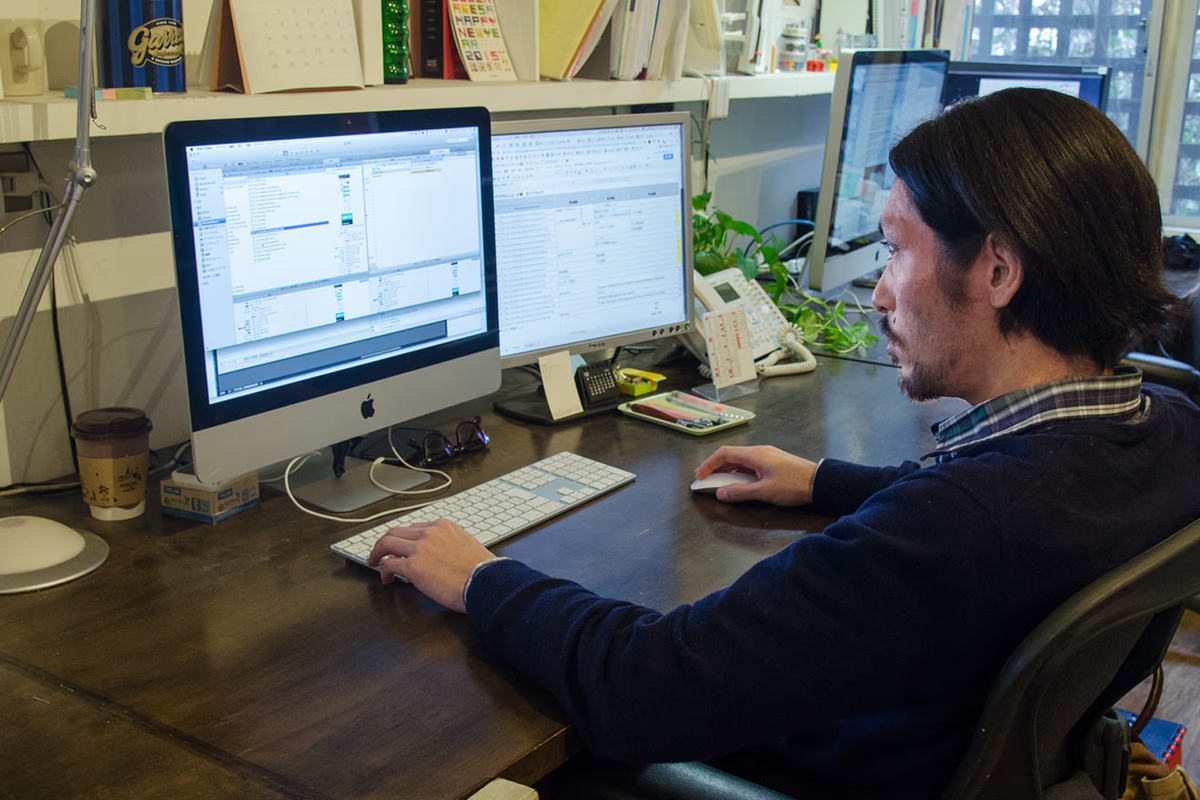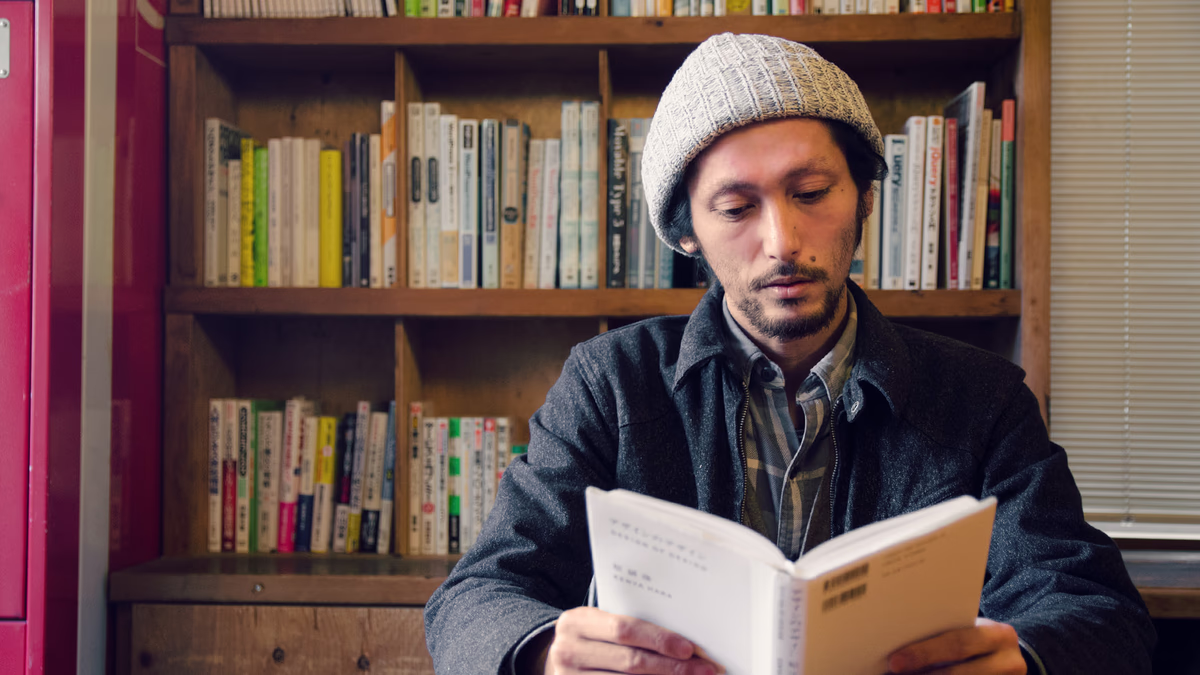デザインが生活の中心になってきた
こんにちは。デザイン部のデザイナー榛葉です。
僕がモノサスに入社したのは2年半ほど前です。
それまでは、本を読んだり友人のデザイナーに相談しながら、PhotoshopやIllustratorなどのアプリケーションの使い方を学び、出来上がったものを複数の友人に見せて、作品を評価してもらうということが、僕のデザインワークの流れでした。
まさか制作会社に入って、デザインが生活の中心になるということを考えたことはなかったのですが、Webのデザインやコードの基礎を学ぶ職業訓練校へ通い始め、そこで学んだことをきっかけに、デザインを仕事にしていきたいと考えるようになりました。
実際にモノサスで、プロのデザイナーやアートディレクターなどの、デザインに関わる仕事をするメンバーから、色や形、書体選びやその間隔の調整など、論理的な実務作業の基本的なノウハウを学び、それを軸にしながら依頼された仕事に取り組んだり、本を読んだりし、デザインへの関わり方に悩むようになり、また新たな視点を持ちながら、試行錯誤を繰り返し次の仕事に取り組み、本やインターネットで情報を収集する日常が当たり前のようになっていました。その中で僕の視野が、特に変化したと感じたことを紹介したいと思います。
デザイナーの役割は、
色や形やサイズを整えるだけではない
これまでにいくつかの仕事に関わりながら、自然に興味を持つようになったことがあります。それは専門用語で言うならUI・UXのことで、簡単に言うとサイトの使いやすさやその体験から得る感覚のことです。
Webデザインというと、それぞれの企業や商品、ブランドのイメージにあった形にすることと単純に捉えていました。しかし、実際に制作に関わってみると、サイトの役割は千差万別で、型にはめるのではなく、それぞれのサービスや目的にマッチさせることがデザインである、ということが見えてきました。その中でも特に視野の広がった2つの仕事があります。
一つは、アジアの建設現場へ重機をレンタルする会社のシステム画面のデザインです。レンタル用重機の保有状況や稼働状況の照会、現場担当者からの発注をもとに受注作業をしていく登録画面、登録後の手配状況を参照する画面など、レンタルから回収までの一連の流れを一つのシステム内で完了し、現場に導入する最新のPC端末のスペックとアジアの各国のインターネット環境でも負荷なく操作できるUIへと再設計するものでした。
もう一つは、高級時計を世界各国の富裕層をターゲットに販売するショッピングサイトの立ち上げです。このサイトの制作では、他のECサイトの機能をリサーチしながら購入者の視点を何度もシミュレーションし、目的の商品や珍しい商品を探しやすいように、条件検索の機能の充実や、その優先順位の精査を細かく行いました。販売者も、商品の登録がしやすく、販売中の商品の管理がしやすいようにすることに注力しました。それに加えて、よりストレスなく使用していただくために、リッチで簡潔な画面遷移を行えるように、都度モックアップを作成しながら、細部の動きや速度の調整などを行い、完成へ近づけていくという制作を行いました。

現在は、CSSやJavaSprictの進化もあって、サイトの動きの表現がとても豊かになってきています。ページの上下のスクロールや、画面遷移用のボタンの挙動など、従来の基本的な動きのみならず、リッチな感覚を反映した各部の動きや、パララックスなどの視覚的に楽しめる動きを、より自然に表現することが必要になってきています。
僕が自然だと感じる感覚と、一般的なエンドユーザーの感覚に差異がないようにするため、たくさんのサイトを訪れ操作し、それを製作中のサイトのモックアップに反映しながら、実質的な体験で感覚の共有が必要となりました。上であげた2サイトののように、直感的な操作性を反映したい場合には、導線をしっかりと整理し、サービスの仕組みをより理解することに時間を費やし、ストレスなく操作が出来るよう、常に考えながらデザインを行いました。
僕も日常的にWebを利用するユーザーなので、OSのことはもちろんのこと、訪れたサイトのページの動き、アプリのボタンの位置や色や形、目的の情報へのたどり着きやすさなどが、上記のような仕事を通して、日々の生活の中でこれまで以上に気にとまるようになり、サイトを訪れた本来の目的以上に、デザイン性を見るようになっていました。
デザインは
社会文化へ深く影響する
もう一つは実践的な体験ではないのですが、本を読んだ中から感じたデザインの幅の広さの話をします。僕はもともと本を読むことが好きではありませんでしたが、10代後半を境によく読書をするようになりました。特に20代は文学小説にに没頭することが多かったのですが、デザインを仕事にするようになった最近は、デザイン関連の本、それに通ずるような新たな知見を与えてくれるような本に出会うことが多く、よく読んでいます。
その中でも特に影響を受けた、デザインの視野の広がる内容だった本を紹介します。
『日本のデザインー美意識がつくる未来』という本です。
著者は日本デザインセンターの代表や武蔵野美術大学の教授を務められている原研哉さんです。この本は、あらゆる面で転換点にある日本の産業・経済を、日本文化の美意識を資源に活性化していこう、ということが書かれています。グラフィックデザインだけでなく、展覧会やプロダクトを通して、日本の美意識を表現されてきた原さんならではの視点で書かれた、とても読み応えのある内容です。
特に共感した点は、「戦後の物資の貧しい時代に渇望したものへの執着(※1)」、「破棄されることを運命づけられた不毛なる生産が意図されている現実(※1)」、「GDPを誇りにしてきた日本の大量生産・大量消費(※1)」について書かれたところです。
富を所有するだけでは幸福になれない。手にしているもの、を適切に運用する文化の質に関与する知恵があった始めて人は充足し、幸せになれる。
原研哉 著「日本のデザインー美意識がつくる未来」岩波新書 2011年 Amazon
上記の文章に加え、前書『デザインのデザイン』で原さんが書かれている「デザインとはものの本質を探り当てる営みである(※2)」、「「もの」ではなく「こと」の創造に関わってきた。(※2)」という言葉を踏まえ、戦後日本が優先してきた生産の加速から、今後は生活の営みの中から生まれる感受性を大切にし、デザインによってその生活文化そのものを豊かにしてゆこうという考え方に納得できました。

左から「日本のデザインー美意識がつくる未来」、「白」、「デザインのデザイン」。いずれも原研哉著。
「繊細」「丁寧」「緻密」「簡潔」─ 千数百年にわたって日本文化の中ではぐくまれてきた美意識を、今後の産業へどう活かしていくのかという視点は、日本を代表するクリエーターである原さんだからこその説得力があります。僕には到底同じように語ることはできないのですが、それでも明るい日本の未来をデザインで活性化していく、ということについてはとても共感でき、これから関わるデザインに少しでも反映ができれば、という意識を持たせてくれます。
※1 原研哉 著「日本のデザインー美意識がつくる未来」岩波新書 2011年 Amazon
※2 原研哉 著「デザインのデザイン」岩波新書 2003年 Amazon
デザインを意識した瞬間から
デザインって何だろう。と考えることすらなく、アプリケーションやモニター上の色や形、大きさやそのバランスにばかり気を取られていた数年前に比べると、少しはデザイナーらしくなってきたのかなと思うこともあります。しかし、デザインについて知れば知るほど、それはどんどん答えの見えにくいものへと変わっていくような気がしています。使う人のこと、提供する人のこと、それが使われる国や地域、そこの文化、とてもたくさんのことを踏まえながらデザインは構成されていくのだと考えるようになりました。関われること、関わりたいことによってその表現の仕方も変わってくるし、僕自身の感覚やイメージも変化していきます。デザインとは、デザイナーやメンバー、クライアントの社会との関わり方によって、常に変化していくものだと現時点では捉えています。
だからこそ、デザインにはよりポジティブに関わっていければと思っています。

